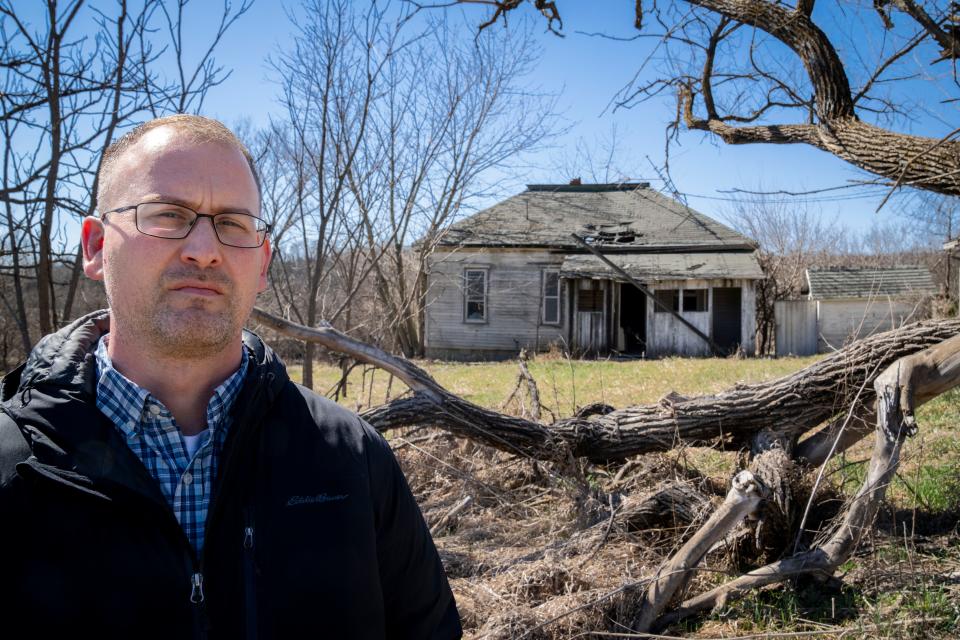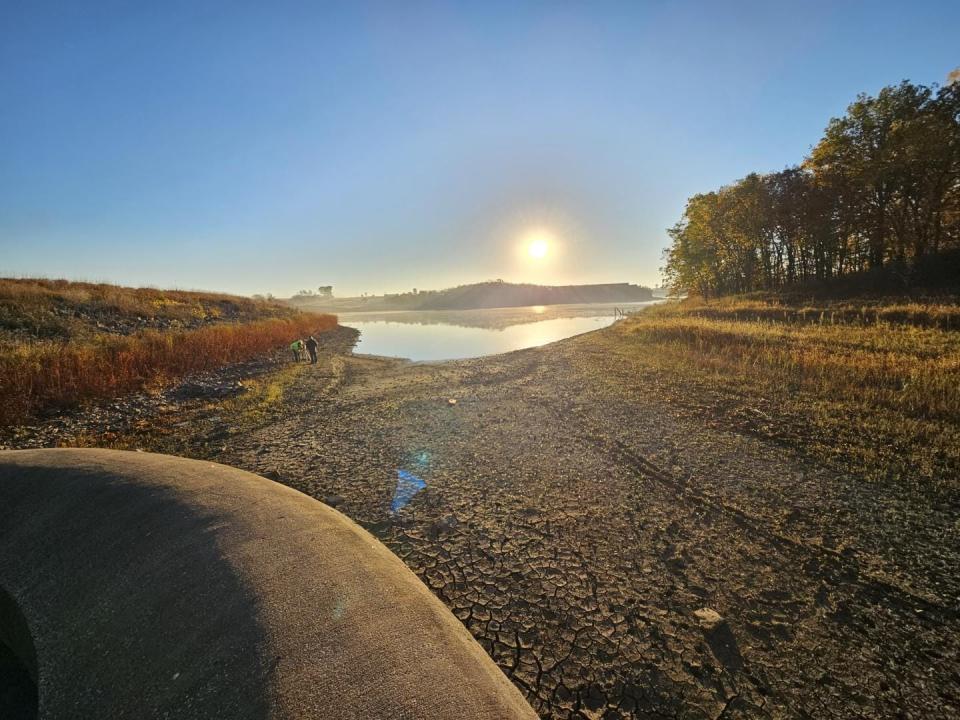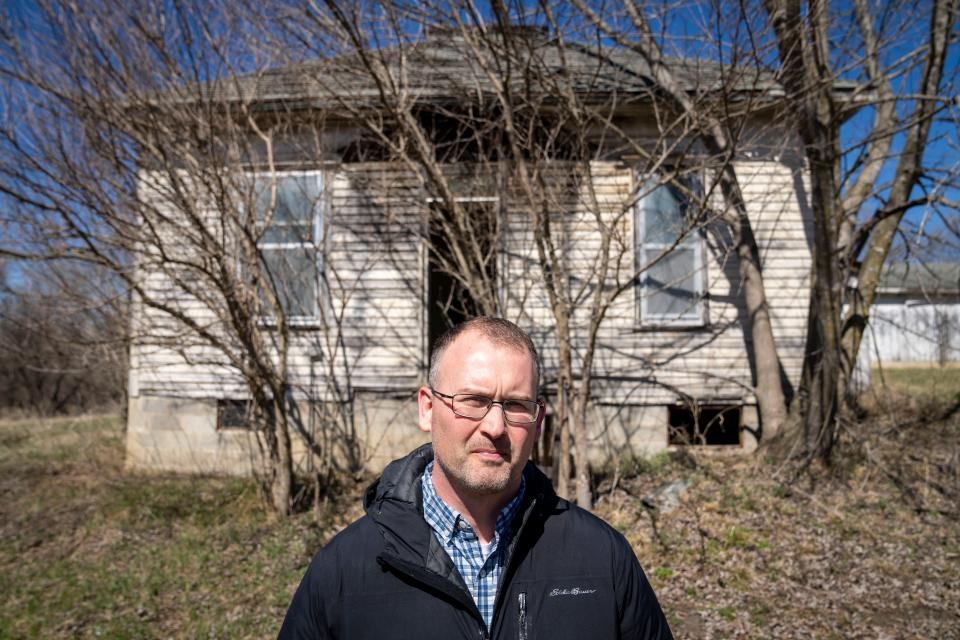Water supply in Osceola dwindles as much-needed south Iowa reservoir delayed by obstacles
OSCEOLA ― To understand the latest obstacle blocking a more than two-decade effort to bring more water supply to a part of the state that really needs it, drive about 6 miles northwest of this south Iowa town and have a look.
Perched in the tall grass on the side of a gravel road near a pile of junk, dead trees and discarded tires are three structures: a weatherworn, early 20th century farmhouse with holes in its floor, ceiling and roof; an abandoned shed; and an equally aged and battered red wooden chicken coop.
Area leaders learned at the end of February that the historic nature of that old farmstead, a common scene of rural decay in the Midwest, could be the next obstacle between them and roughly $60 million in federal funding needed to begin work on a new reservoir in the South West Creek watershed.

The huge project, local officials say, could eventually serve as many as 30,000 people in drought-ridden south-central Iowa and northern Missouri. But the list of problems that have confronted the effort, most tying back to Iowa state officials, has run so long that some local leaders don’t think it’s a coincidence.
“The need for water here is well-documented, and now the crisis we feared is being realized,” Osceola City Manager Ty Wheeler said. “But these are the ridiculous things we are having to go through.”
The one-time home of Iowa Gov. Kim Reynolds, a former Clarke County treasurer, Osceola has known for more than 20 years that the region will need a new water source. But its declining water supply amid the state’s fourth year of drought ― the longest stretch in two decades ― has brought new urgency.
Nearly all of Clarke County, where Osceola is the county seat, is experiencing severe or extreme drought. It’s so bad that residents have been put on notice to use bottled water instead of tap. And if the area’s dwindling primary source of residential and industrial water, 377-acre West Lake, recedes a couple of more feet, major regional employers like Hormel Foods, livestock producers and area residents will not have enough water to go on without other measures.
More Watchdog: He went to get medication for ADHD. MercyOne charged him nearly $1,500 in facility fees.
As Osceola leaders waited for the money, planning and permission needed to begin work on the new reservoir, they asked state regulators in October to allow it to use treated wastewater to recharge West Lake. The request to the Iowa Department of Natural Resources to pursue the $16.5 million project was the first in the state seeking to recycle wastewater to supply drinking water.
The plan has taken much back and forth between local authorities and the DNR. But it’s looking like it’s moving forward and expected to produce a product “as clean as distilled water,” Wheeler said.
But to solve the longer-term problem, the Clarke County Reservoir Commission believes construction of the new reservoir is imperative. After the devastating loss of federal Natural Resources Conservation Service funding for the project due to budget cuts in 2011, Osceola and a group of other local governments, agencies and regional waterworks moved forward without a federal partner.
In the ensuing years, the commission has faced significant political challenges as it attempts to acquire the land needed in and around the site of the envisioned 800-acre reservoir. It sought to use eminent domain, but a state appropriations bill passed in 2015, put forward by the Legislature’s Republican majority, added prohibitions on eminent domain for counties exactly the size of Clarke.
The commission eventually found another way to proceed, and members thought its most difficult challenges were behind it, Wheeler said.
Commission's question: Is the state preserving or meddling?

In 2020, after the commission prepared the site and tore down some homes in anticipation of the project, the U.S. Natural Resources Conservation Service agreed once more to help finance the project, with about $60 million.
But to move forward, the commission needs the Iowa State Historical Preservation Office’s blessing to eventually receive the federal money. That state office, now under the Iowa Economic Development Authority and its leader Debi Durham since last year’s state government reorganization, administers federal programs.
But a year ago this month, local leaders say, archaeologists at the State Historic Preservation Office raised new problems with federal officials.
One sent an email to officials at the NRCS, the U.S. Department of Agriculture and U.S. Army Corps of Engineers that, among other things, voiced concerns about “anticipatory activities” taken by the commission as it had prepared the area for the project.
More Watchdog: Iowa settles suit over another inappropriate sexual relationship at Eldora state school
The email from Daniel Higgenbottom urged NRCS and the Corps of Engineers to investigate the commission's actions “to determine if any resulted in adverse effects to historic properties” that may be subject to the National Historic Preservation Act. The email also voiced concerns about any other plans to destroy “standing structures” and about earthmoving that could occur at the site.
In years prior, when the commission had relocated some homes and demolished others near the reservoir site, the NRCS hadn’t been involved and the preservation act wasn't in play.
Higgenbottom suggested the commission’s actions could have violated federal law, “thereby compromising or otherwise complicating a federal agency’s ability to successfully navigate through and complete federal review and compliance processes.”
He also mentioned a Native American mound just outside the reservoir area, and advised that it should be further investigated with research and sampling.
More: Ocheyedan River again goes dry despite new Iowa DNR requirements
A subsequent email in January from state archaeologist Branden Scott suggested the NRCS, the federal agency most likely to lead the project, had not “considered all effects and potential historic properties.” Some properties, the historic preservation office said, were historic farms or homes that were removed from 2019 to 2021, but most were outside the area potentially affected by the new reservoir.
The move set in motion new hurdles for local officials because the state archaeologist was saying a deeper review of the project was necessary.
Then, this March, Sara André, an architectural historian with the same state office, sent another email to the federal authorities. André took issue with a new consultant’s survey of the area that found the old farmstead was not eligible to be placed on the National Register of Historic Places.
To be eligible for the register, sites have to meet certain criteria and possess “integrity,” conveying significance through physical features and context.
André thought the site did.
“While the Farmstead may be in poor condition, the integrity of the resources is good,” she argued. “The farmstead does represent an early-mid 20th century farm in a time when farms were evolving and changing, representing shifts in methods, equipment, etc. And as such, it appears that the Hofbauer Farmstead, 1913 Orange St., Osceola, is eligible.”
So regional officials are once again stalled, waiting to see how the NRCS will react.
If the agency determines there could be an adverse effect, then it has to consult further on appropriate measures needed to avoid, minimize, or mitigate that effect.
Wheeler said the correspondence from the state office bothered him because it seems like overreach for a state agency that is essentially a middleman between local authorities and the federal government. At the point the first email by an archaeologist was sent, he said, the NRCS hadn’t even done any of its own field work.
More: Water-supply issues in some Iowa cities continue after disappointing winter precipitation
The email from André riled up the Osceola City Council because it felt the structures referenced were not salvageable or historically significant.
And the historic preservation office’s actions triggered new investigations that could push the project’s groundbreaking back even father ― to 2025 or 2026.
“There’s this growing sense that bigger things are at work that are preventing this project from moving forward,” Wheeler said.
The Iowa Economic Development Authority, the historic preservation office's parent agency, did not respond to a request for comment.
'People are finally returning our calls.'

Tom Bahls, an Osceola City Council member, said that until last week, there was no urgency from the governor’s office or the state to help the area with the project, which is the biggest issue in the region right now.
But after some state officials went to a conference recently in Denver that helped them better understand temporary plans to use retreated wastewater ― and Watchdog’s inquiries with the IEDA and historic preservation office ― things seem to have turned a corner.
The city manager, council members, water board officials and others have been invited to meet with representatives of the governor’s office on Tuesday, Bahls said, to discuss short-term and long-term support for the project.
At the Denver conference, also attended by some state legislators, he said, there were officials from 22 other states who want to use treated wastewater to help with water shortages.
“Things are moving. People are finally returning our calls,” he said. “I’m hoping it is partly because of questions they were fielding from you.”
The local commission wants to do “everything properly and legally,” he said. “But I think the state is finally seeing that our need is one of urgency.”

Lee Rood's Reader's Watchdog column helps Iowans get answers and accountability from public officials, the justice system, businesses and nonprofits. Reach her at lrood@registermedia.com, at 515-284-8549, on Twitter at @leerood or on Facebook at Facebook.com/readerswatchdog.
This article originally appeared on Des Moines Register: Osceola leaders believe south Iowa reservoir plans blocked by politics

